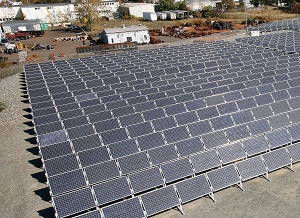Week in Review: Shifts in solar
 This past week saw some interesting moves in solar. For instance, people are increasingly looking at grid storage solutions to make solar more viable for the grid. At the same time at least one solar company is working to rebrand itself in image of Expedia and as some modules are proving defective at least one law firm is anticipating that solar installers and manufacturers could find themselves mired in lawsuits. Most defective panels are coming out of China, which soon may face more tariffs, this time, from Europe.
This past week saw some interesting moves in solar. For instance, people are increasingly looking at grid storage solutions to make solar more viable for the grid. At the same time at least one solar company is working to rebrand itself in image of Expedia and as some modules are proving defective at least one law firm is anticipating that solar installers and manufacturers could find themselves mired in lawsuits. Most defective panels are coming out of China, which soon may face more tariffs, this time, from Europe.
Despite opposition from countries in Europe, including Germany, the European Union may impose sanctions on imported PV modules that are manufactured in China, similar to those passed in the US last year. The levies would combat the alleged anti-competitive practices of Chinese manufacturers to sell their modules at lower than market costs. Any levies or fines imposed by EU could be more damaging to the Chinese PV industry than those passed in the US, since Europe has been a larger market for the Chinese imports than the US has.
Chinese modules were also singled out for being the most likely to be defective, a New York Times story reported last week. Subsequently Anderson Kill's Scott Turner, a lawyer who specializes in Insurance Recovery, Real Estate and Construction, posited that if defective rates of modules are high, this could lead to legal battles with manufacturers and installers, which could be in the range of billions of dollars of lawsuits.
Now that solar technologies are maturing and becoming more mainstream, there could be a shift to strengthening energy storage on the grid. A new report from Lux Research anticipates that the energy storage market could grow from a $200 million industry in 2013 to a $10.4 billion industry by 2017. The growth in energy storage will help increase interest in renewables because it will help make renewable energy a more viable energy source.
Meanwhile One Block Off The Grid, aka 1BOG, is changing its business focus. The company was primarily focussed on group purchasing programs but now is apparently attempting to shift its strategy to becoming an online marketplace for solar, which it likens to an Expedia for the solar industry. The new services it’s launching intend to connect online shoppers with options from multiple installers much like Expedia does for airline tickets and progressive does for auto insurance.
Solar gardens continue to grow in popularity as well. Up in Michigan, the Solar Up North (SUN) Alliance, led by Cherryland Electric Cooperative, is developing a community solar project with 80 modules to start. Coop members can purchase a module for about $470—and then receive at least a $75 rebate. As their module or modules produce electricity, participants’ electric bills are discounted for the electric produced.
The 130 megawatt Tenaska Imperial Solar Energy Center South went live last week. The solar farm is the first utility scale project to be connected to San Diego Gas & Electric’s (SDG&E’s) Sunrise Powerlink, a high-voltage transmission line developed to bring clean energy to San Diego’s residents. It might be the first high-energy transmission line developed exclusively for clean energy.




